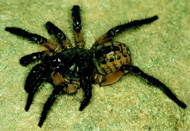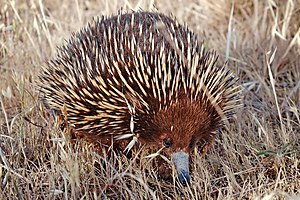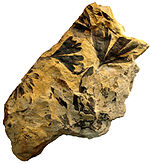User:Jaspergeli/Living fossil

A living fossil is an extant taxon that closely resembles organisms otherwise known only from the fossil record. As a rule, to be considered a living fossil, the fossil species must be old relative to the time of origin of the extant clade. Living fossils commonly are species-poor lineages, but they need not be. The term living fossil is not formally defined, but in the scientific literature, the term usually connotes a bradytelic group. "Bradytely", however, is rarely used in the modern scientific literature but the characteristic of a bradytelic group is that its changes fluctuate on a small scale and do not accumulate over time. In modern literature, the term most often used for that distinctive evolutionary tempo is "stasis". Living fossils exhibit stasis over geologically long timescales.
In popular literature "living fossil" commonly embodies radical misunderstandings such as that the organism somehow has undergone no significant evolution since fossil times, with practically no molecular evolution or morphological, but scientific investigations have repeatedly discredited any such claims about molecular evolution. An important misunderstanding underlying the idea that living fossils do not evolve is that stabilizing selection is an evolutionary process, perhaps even the dominant one in morphological evolution.
Overview[edit]
Living fossils have two main characteristics, although some have a third. The first two are required for recognition as a living fossil stasis but some authors include the third. They:
- are members of taxa that exhibit notable longevity in the sense that they have remained recognisable in the fossil record over unusually long periods;
- show little morphological divergence, whether from early members of the lineage, or among extant species, and
- tend to have little taxonomic diversity.
Such criteria are neither well-defined nor clearly quantifiable, but modern methods for analyzing evolutionary dynamics can document the distinctive tempo of stasis. Lineages that exhibit stasis over very short time scales are not considered living fossils; what is poorly-defined is the time scale over which the morphology must persist for that lineage to be recognized as a living fossil.
The term "living fossil" is much misunderstood in popular media in particular, in which it often is used meaninglessly. In professional literature, the expression seldom appears and must be used with far more caution and it has been used inconsistently.
One example of a concept that could be confused with "living fossil", is that of a "Lazarus taxon", but the two are not equivalent; a Lazarus taxon (whether a single species or a group of related species) is one that suddenly reappears, either in the fossil record or in nature, as if the fossil had "come to life again". In contrast to Lazarus taxa, a living fossil in most senses is a species or lineage that has undergone exceptionally little change throughout a long fossil record, giving the impression that the extant taxon had remained identical through the entire fossil and modern period.
The average species turnover time, meaning the time between when a species first is established and when it finally disappears, varies widely among phyla, but averages about 2–3 million years. So a living taxon that had long been thought to be extinct could be called a Lazarus taxon once it was discovered to be still extant. A dramatic example was the order Coelacanthiformes, of which the genus, Latimeria was found to be extant in 1938. About that there is little debate. However, whether Latimeria resembles early members of its lineage sufficiently closely to be considered a living fossil as well as a Lazarus taxon, has been denied by some authors in recent years.
Coelacanths disappeared from the fossil record some 80 million years ago (upper Cretaceous) and to the extent that they exhibit low rates of morphological evolution, extant species qualify as living fossils. It must be emphasized that this criterion reflects fossil evidence, and is totally independent of whether the taxons had been subject to selection at all, which all living populations continuously are, whether they remain genetically unchanged or not. This, in turn, gives rise to a great deal of confusion; for one thing, the fossil record seldom preserves much more than the general morphology of a specimen; to determine much about its physiology is seldom possible. To determine much about its noncoding DNA is hardly ever possible, but even if a species were hypothetically unchanged in its physiology, it is to be expected from the very nature of the reproductive processes, that its non-functional genomic changes would continue at more or less standard rates. It follows that a fossil lineage with apparently constant morphology need not imply equally constant physiology for example, and certainly neither implies any cessation of the basic evolutionary processes such as natural selection, nor reduction in the usual rate of change of the noncoding DNA. In short, not even the most dramatic examples of living fossils can be expected to be without changes, no matter how persistently constant their fossils and their extant specimens might seem.
Some living fossils are taxa that were known from palaeontological fossils before living representatives were discovered. The most famous examples of this are:
- Coelacanthiform fishes Latimeria chalumnae and Latimeria menadoensis
- Metasequoia, the dawn redwood discovered in a remote Chinese valley
- glypheoid lobsters
- mymarommatid wasps, eomeropid scorpionflies
- jurodid beetles
All of these were described from fossils before later found alive (2 species, 10 species, one species, and one species respectively).
Other examples of living fossils are single living species that have no close living relatives but are survivors of large and widespread groups in the fossil record. Consider:
- Ginkgo biloba
- Syntexis libocedrii, the cedar wood wasp
- Dinoflagellates include taxa that originally were described as fossils (being typified on coccoid, occasionally calcareous cell remnants: dinocysts), but now are known to include still-extant species.
The fact that a living fossil is a surviving representative of an archaic lineage does not imply that it must retain all the "primitive" features (plesiomorphies) of its ancestral lineage. Although it is common to say that living fossils exhibit "morphological stasis", stasis, in the scientific literature, does not mean that any species is strictly identical to its ancestor, much less remote ancestors.
Some living fossils are relicts of formerly diverse and morphologically varied lineages, but not all survivors of ancient lineages necessarily are regarded as living fossils. See for example the uniquely and highly autapomorphic oxpeckers, which appear to be the only survivors of an ancient lineage related to starlings and mockingbirds.
Evolution and living fossils[edit]
The term living fossil is usually reserved for species or larger clades that are exceptional for their lack of morphological diversity and their exceptional conservatism, and several hypotheses could explain morphological stasis on a geologically long time-scale. Early analyses of evolutionary rates emphasized the persistence of a taxon rather than rates of evolutionary change. Contemporary studies instead analyze rates and modes of phenotypic evolution, but most have focused on clades that are thought to be adaptive radiations rather than on those thought to be living fossils. Thus, very little is presently known about the evolutionary mechanisms that produce living fossils or how common they might be. Some recent studies have documented exceptionally low rates of ecological and phenotypic evolution despite rapid speciation. This has been termed a "non-adaptive radiation" referring to diversification not accompanied by adaptation into various significantly different niches. Such radiations are explanation for groups that are morphologically conservative. Persistent adaptation within an adaptive zone is a common explanation for morphological stasis. The subject of very low evolutionary rates, however, has received much less attention in the recent literature than that of high rates
Living fossils are not expected to exhibit exceptionally low rates of molecular evolution, and some studies have shown that they do not. For example, on tadpole shrimp (Triops), one article notes, "Our work shows that organisms with conservative body plans are constantly radiating, and presumably, adapting to novel conditions... I would favor retiring the term ‘living fossil’ altogether, as it is generally misleading."
The question posed by several recent studies pointed out that the morphological conservatism of coelacanths is not supported by paleontological data. In addition, it was shown recently that studies concluding that a slow rate of molecular evolution is linked to morphological conservatism in coelacanths are biased by the a priori hypothesis that these species are ‘living fossils’. Accordingly, the genome stasis hypothesis is challenged by the recent finding that the genome of the two extant coelacanth species L. chalumnae and L. menadoensis contain multiple species-specific insertions, indicating transposable element recent activity and contribution to post-speciation genome divergence. Such studies, however, challenge only a genome stasis hypothesis, not the hypothesis of exceptionally low rates of phenotypic evolution.
History[edit]
The term was coined by Charles Darwin in his On the Origin of Species from 1859 when discussing Ornithorhynchus (the platypus) and Lepidosiren (the South American lungfish):
... All fresh-water basins, taken together, make a small area compared with that of the sea or of the land; and, consequently, the competition between fresh-water productions will have been less severe than elsewhere; new forms will have been more slowly formed, and old forms more slowly exterminated. And it is in fresh water that we find seven genera of Ganoid fishes, remnants of a once preponderant order: and in fresh water we find some of the most anomalous forms now known in the world, as the Ornithorhynchus and Lepidosiren, which, like fossils, connect to a certain extent orders now widely separated in the natural scale. These anomalous forms may almost be called living fossils; they have endured to the present day, from having inhabited a confined area, and from having thus been exposed to less severe competition.
Other definitions[edit]
Long-enduring[edit]

A living taxon that lived through a large portion of geologic time.[citation needed]
Queensland lungfish (Neoceratodus fosteri) is an example of an organism that meets this criterion. Fossils identical to modern Queensland lungfish have been dated at over 100 million years making this species one of the oldest if not actually the oldest extant vertebrate species.
Resembles ancient species[edit]
A living taxon morphologically and/or physiologically resembling a fossil taxon through a large portion of geologic time (morphological stasis).
Retains many ancient traits[edit]

A living taxon with many characteristics believed to be primitive.[citation needed]
This is a more neutral definition. However, it does not make it clear whether the taxon is truly old, or it simply has many plesiomorphies. Note that, as mentioned above, the converse may hold for true living fossil taxa; that is, they may possess a great many derived features (autapomorphies), and not be particularly "primitive" in appearance.
Relict population[edit]
Any one of the above three definitions, but also with a relict distribution in refuges.[citation needed]
Some paleontologists believe that living fossils with large distributions (such as Triops cancriformis) are not real living fossils. In the case of Triops cancriformis (living from the Triassic until now), the Triassic specimens lost most of their appendages (mostly only carapaces remain), and they have not been thoroughly examined since 1938.
Low diversity[edit]
Any of the first three definitions, but the clade also has a low taxonomic diversity (low diversity lineages).[citation needed]
Oxpeckers are morphologically somewhat similar to starlings due to shared plesiomorphies, but are uniquely adapted to feed on parasites and blood of large land mammals, which has always obscured their relationships. This lineage forms part of a radiation that includes Sturnidae and Mimidae, but appears to be the most ancient of these groups. Biogeography strongly suggests that oxpeckers originated in eastern Asia and only later arrived in Africa, where they now have a relict distribution.
The two living species thus seem to represent an entirely extinct and (as Passerida go) rather ancient lineage, as certainly as this can be said in the absence of actual fossils. The latter is probably due to the fact that the oxpecker lineage never occurred in areas where conditions were good for fossilization of small bird bones, but of course, fossils of ancestral oxpeckers may one day turn up enabling this theory to be tested.
Operational definition[edit]
- Proposed in 2017: lineage has a slow rate of evolution and occurs close to the centroid of the lineage's morphospace.
Examples[edit]

Some of these are informally known as "living fossils".
Bacteria[edit]
- Stromatolite, a layered structure created as sediment is trapped by shallow-water, oxygen-creating, blue-green bacteria
Protists[edit]
- The dinoflagellate †Calciodinellum operosum.
- The dinoflagellate †Dapsilidinium pastielsii.
- The dinoflagellate †Posoniella tricarinelloides.
- The coccolithophore Tergestiella adriatica.
Plants[edit]
- Pteridophytes
- Horsetails – Equisetum
- Lycopodiums
- Tree ferns
- Moss
- Gymnosperms
- Agathis - Agathis in Australia and the Pacific including Almasiga trees in the Philippines
- Araucaria araucana – the monkey puzzle tree (as well as other extant Araucaria species)
- Cycads
- Ginkgo tree (Ginkgoaceae)
- Metasequoia – dawn redwood (Cupressaceae; related to Sequoia and Sequoiadendron)
- Sciadopitys "Japanese umbrella pine"
- Taiwania cryptomerioides – one of the largest tree species in Asia.
- Wollemia tree (Araucariaceae – a borderline example, related to Agathis and Araucaria)
- Welwitschia
- Angiosperms
- Amborella – a plant from New Caledonia, possibly closest to base of the flowering plants
- Trapa - water caltrops, seeds, and leaves of numerous extinct species are known all the way back to the Cretaceous.
- Nelumbo - several species of lotus flower are known exclusively from fossils dating back to the Cretaceous.
Fungi[edit]
Animals[edit]
- Vertebrates

Echidnas are one of few mammals to lay eggs.



- Mammals
- Aardvark (Orycteropus afer)
- Amami rabbit (Pentalagus furnessi)
- Chevrotain (Tragulidae)[citation needed]
- Elephant shrew (Macroscelidea)[citation needed]
- Laotian rock rat (Laonastes aenigmamus)[citation needed]
- Monito del monte (Dromiciops gliroides)
- Monotremes (the platypus and echidna)
- Mountain beaver (Aplodontia rufa)
- Okapi (Okapia johnstoni)
- Opossums (Didelphidae)
- Capybara (Hydrochoerus hydrochaeris)[citation needed]
- Red panda (Ailurus fulgens)
- Solenodon (Solenodon cubanus and Solenodon paradoxus)
- Shrew opossum (Caenolestidae)
- False killer whale (Pseudorca crassidens)
- Pygmy right whale (Caperea marginata)
- Birds
- Pelicans (Pelecanus) – Morphology has been virtually unchanged since the Eocene, and is noted to have been even more conserved across the Cenozoic than that of crocodiles.
- Acanthisittidae (New Zealand "wrens") – 2 living species, a few more recently extinct. Distinct lineage of Passeriformes.
- Broad-billed sapayoa (Sapayoa aenigma) – One living species. Distinct lineage of Tyranni.
- Bearded reedling (Panurus biarmicus) – One living species. Distinct lineage of Passerida or Sylvioidea.
- Coliiformes (mousebirds) – 6 living species in 2 genera. Distinct lineage of Neoaves.
- Hoatzin (Ophisthocomus hoazin) – One living species. Distinct lineage of Neoaves.
- Magpie goose (Anseranas semipalmata) – One living species. Distinct lineage of Anseriformes.
- Seriema (Cariamidae) – 2 living species. Distinct lineage of Cariamae.
- Tinamiformes (tinamous) 50 living species. Distinct lineage of Palaeognathae.
- Reptiles
- Alligator snapping turtle (Macrochelys temminckii)
- Crocodilia (crocodiles, gavials, caimans and alligators)
- Pig-nosed turtle (Carettochelys insculpta)
- Snapping turtle (Chelydra serpentina)
- Tuatara (Sphenodon punctatus and Sphenodon guntheri)
- Amphibians
- Giant salamanders (Cryptobranchus and Andrias)
- Hula painted frog (Latonia nigriventer)
- Purple frog (Nasikabatrachus sahyadrensis)
- Jawless fish
- Hagfish (Myxinidae) Family
- Bony fish
- Arowana and arapaima (Osteoglossidae)
- Bowfin (Amia calva)
- Coelacanth (the lobed-finned Latimeria menadoensis and Latimeria chalumnae)
- Gar (Lepisosteidae)
- Queensland lungfish (Neoceratodus fosteri)
- Sturgeons and paddlefish (Acipenseriformes)
- Bichir (Polypteridae) family
- Protanguilla palau
- Mudskipper (Oxudercinae)
- Sharks
- Blind shark (Brachaelurus waddi)
- Bullhead shark (Heterodontus sp.)
- Elephant shark (Callorhinchus milii)
- Frilled shark (Chlamydoselachus sp.)
- Goblin shark (Mitsukurina owstoni)
- Gulper shark (Centrophorus sp.)
- Invertebrates

Nautilus retain the external spiral shell that its other relatives have lost.

- Insects
- Mantophasmatodea (gladiators; a few living species)
- Meropeidae (3 living species, 4 extinct)
- Micromalthus debilis (a beetle)
- Mymarommatid wasps (10 living species in genus Palaeomymar)
- Nevrorthidae (3 species-poor genera)
- Nothomyrmecia (known as the dinosaur ant)
- Notiothauma reedi (a scorpionfly relative)
- Orussidae (parasitic wood wasps; about 70 living species in 16 genera)
- Peloridiidae (peloridiid bugs; fewer than 30 living species in 13 genera)
- Sikhotealinia zhiltzovae (a jurodid beetle)
- Syntexis libocedrii (Anaxyelidae cedar wood wasp)
- Crustaceans
- Glypheoidea (2 living species: Neoglyphea inopinata and Laurentaeglyphea neocaledonica)
- Stomatopods (mantis shrimp)
- Triops cancriformis (also known as tadpole shrimp; a notostracan crustacean)
- Molluscs
- Other invertebrates
- Crinoids
- Horseshoe crabs (only 4 living species of the class Xiphosura, family Limulidae: Limulus polyphemus, Tachypleus gigas, Tachypleus tridentatus, and Carcinoscorpius rotundicauda)
- Lingula anatina (an inarticulate brachiopod)
- Liphistiidae (trapdoor spiders)
- Onychophorans (velvet worms)
- Valdiviathyris quenstedti (a craniforman brachiopod)
- Paleodictyon nodosum (unknown)




